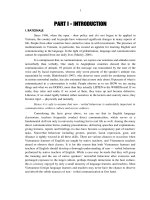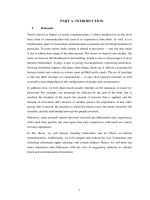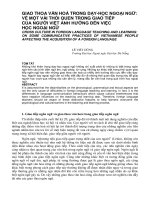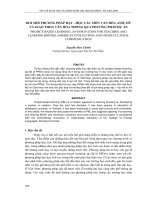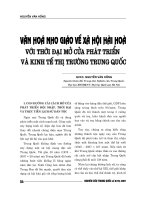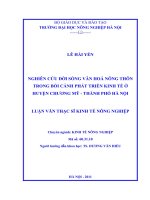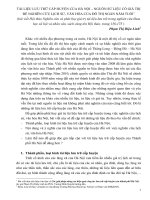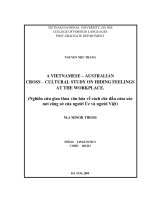Nghiên cứu giao thoa văn hoá việt mỹ về cách rào đón khi từ chối lời mời
Bạn đang xem bản rút gọn của tài liệu. Xem và tải ngay bản đầy đủ của tài liệu tại đây (322.58 KB, 42 trang )
1
1. Rationale
An emphasis on language as a communication system is really necessary in an age of
globalization. Not only does it help uncover principles underlying social interactions, but it
also enables us to gain an access to ways of thinking, belief systems, and world views of
people from various cultural backgrounds and thus enhances empathy and mutual
understanding. Investigating issues concerning cross-cultural communication is especially
momentous in today’s time, when national boundaries are becoming less visible, and more
and more people are engaging in intercultural communication. Understanding social
conventions and attention to such concepts as politeness, and face, which are important to
members in a particular culture, will certainly enable us to better comprehend the different
ways of speaking by people from different cultures, thus helping eliminate ethnic
stereotypes and misunderstandings.
There have been so far plenty of researches on the field of politeness from various
perspectives. Yet, hedging in language is still an area available for more exploration. This
research, therefore, has chosen hedging as a potential subject. The study is done not only to
see the similarities and dissimilarities between the two cultures. Another goal of this
research is to raise the awareness of both teachers and learners of English about the
necessity of hedging in language, and to give teachers several suggestions in teaching this
language phenomenon to their students.
Nevertheless, hedging is a very broad area, and within the limit of the study, it is
impossible to discuss all aspects of hedging in language. As declining an invitation is an
act with high risk of making the hearers lose face, it requires different supplementary steps
to reduce the weightiness of the utterance. This is where hedging can mostly be seen. That
is the reason why hedging in invitation declining is chosen for the project.
The study has also derived from the need for improvement in English teaching process in
Thang Long University, where American-English course books The New Interchange 1, 2,
3 are employed. This study, therefore, has focused on comparing American and
2
Vietnamese cultures, with the hope to pay a humble contribution to the people who the
thesis author has owed so much for their love and support: colleagues and students.
For any of those purposes, the study promises to make itself meaningful, reliable and
applicable to the reality.
2. Scope of the study
• Within the limit of a minor thesis, the research has been carried out in the office
setting. Participants selected are people who are currently working in offices. The
reasons for choosing this setting are: (1) it is suitable with the size of a minor
thesis; (2) it includes various common kinds of relationship, which promises a
meaningful research.
• The study has been done from the perspective of pragmatics where Vietnamese and
American hedging in invitation declining is analyzed as speech acts in particular
contexts. However, semantic and syntactic theories are employed at times to help
better analyze different hedging strategies.
• Hedging is known available in both spoken and written language. Yet, in this
research, the focus will be paid on hedging in spoken language only.
• Though paralinguistic and extra-linguistic factors play a very important part in
communication, the study is restricted to verbal aspect of hedging in invitation
declining.
3. Aims of the study
The main aims of the study are to:
• find out the similarities and differences in the way Vietnamese and American
people hedge when declining an invitation.
• help avoid potential cross-cultural conflicts between Vietnamese and American
speakers, with focus on the proper use of hedging in invitation declining.
3
• provide language teachers and learners with an insight into hedging in invitation
declining employed by Vietnamese and American speakers to avoid hurting their
partners.
• give some suggestions on teaching hedging in the situations of invitation declining.
4. Methodology
This is mainly a quantitative method, specifically, a survey research. Survey research is the
method of gathering data from respondents supposed to be representative of some
population, using an instrument composed of closed structure or open-ended items
(questions). In a survey, researchers sample a population. Since populations can be quite
large, researchers directly question only a sample (i.e. a small proportion) of the
population. That is why survey research is a suitable choice for a cross-cultural study.
The questionnaire is designed carefully basing on some hypothesis with both close-ended
and open-ended questions. The data collected will then be analyzed to find out the
similarities and differences in hedging an invitation decline between the American and the
Vietnamese from different perspectives, age, gender, power, distance, and circumstance.
The evaluations and comments on the results, hence, are made inductively.
In addition, personal observation and some small interviews with the participants play a
very significant part in the study, especially in setting up the hypothesis and making
interpretation for the statistics.
5. Comments on the participants
The survey questionnaires were sent to thirty American and thirty Vietnamese participants.
As the scope of the research is to investigate hedging in invitation declining in office
setting, the participants are those who are currently working in offices, mean age is 28.33.
The numbers of males and females are equal in each group, i.e., 15 males and 15 females
for each party. These are Native American and Vietnamese people, not immigrants, so that
the results of the survey will hopefully be reliable.
4
1. Theoretical Background
1.1. Hedging
There have been so far two main approaches about hedging. The term ‘hedge’/ ‘hedging’
itself was introduced first by G. Lakoff (1972) in his article ‘Hedges: A Study in Meaning
Criteria and the Logic of Fuzzy Concepts’. Lakoff argues that the logic of hedges requires
serious semantic analysis for all predicates. He defines hedges as follows:
For me, some of the most interesting questions are raised by the study of words whose
meaning implicitly involves fuzziness - words whose job it is to make things fuzzier or less
fuzzy. I will refer to such words as 'hedges'
(1972:195)
In his article "Fuzzy-Set - Theoretic Interpretation of Linguistic Hedges", Zadeh (1972)
followed Lakoff in using the new designation ‘hedge’ and analyzed English hedges (such
as simple ones like ‘very’, ‘much’, ‘more or less’, ‘essentially’, and ‘slightly’ and more
complex ones like ‘technically’ and ‘practically’) from the point of view of semantics and
logics. The author assumes that hedges are operators that act on the fuzzy set representing
the meaning of their operands. Hedges vary in their dependency on context.
Later on, hedging has been viewed from the perspective of pragmatics. The concept of
hedge/ hedging is understood in different ways in the literarture. Hedges have been
referred to as compromisers (James,1983), downtoners (Quirk at all, 1972,1985),
understatements (Hubler, 1983), weakeners (Brown and Levinson, 1987), downgraders
(House and Kasper, 1981), softeners (Crystal & Davy, 1975), backgrounding terms (Low,
1996), approximators and shields (Prince at all.1982) and pragmatic devices (Subble &
Homes, 1995), mitigators (Labov and Fanshel 1977, Stubbs, 1983), tentativeness (Homes,
1983,1995) and vagueness (Channell 1994).
5
Brown & Levinson (1978, 1987), dealing with politeness in verbal interaction from the
point of view of pragmatics, viewed hedges as a device to avoid disagreement. Brown and
Levinson (1987: 145) define ‘hedges’ as:
…a particle, word or phrase that modifies the degree of membership of a predicate or
noun phrase in a set; it says of that membership that it is partial, or true only in certain
respects, or that it is more true and complete than might be expected'
(1987:146)
Vietnamese linguists such as Nguyn Thin Giáp (2000), Hoàng Phê (2002), Nguyn
Quang (2003) also view hedging as a pragmatic phenomenon. Hoàng Phê in his
Vietnamese Dictionary states that ‘hedges are expressions which are preventive from
[unexpected] misunderstanding and reaction/responses to what is said’. According to
Nguyn Quang (2003), hedging is a strategy used simply to hedge the propositional
content.
In this paper, we mainly view hedging from pragmatic perspective. In pragmatics, the
concept of hedging is mainly linked to the concept of speech act and politeness
phenomena. A hedge is either defined as one or more lexico-syntactical elements that are
used to modify a proposition, or else, as a strategy that modifies a proposition. A hedge can
appear before or after a proposition. The term ‘hedging’ is used to refer to the textual
strategies of using linguistic means as hedges in a certain context for specific
communicative purposes.
1.2. Hedges and Speech Acts
Hedging, when being viewed from pragmatic perspective, is surely linked to a very
common pragmatic perception: speech act, as speech act is ‘one of the central phenomena
that any general pragmatic theory must account for’ (S.C Levinson 1983:226).
So what is a speech act? In fact, speech act theory is built on the foundation laid by
Wittgenstein and Austin. In his book Philosophical Investigations (1958), Ludwig
Wittgenstein set forth with an idea called ‘ordinary language philosophy’. He believed that
the meaning of language depends on its actual use. Language, as used in ordinary life, is a
6
kind of ‘language games’ because it consists of rules. In other words, people follow rules
to do things with the language.
It was in this same period that Austin launched his theory of speech acts. He insisted that
‘the total speech act in the total speech situation is the only actual phenomenon which, in
the last resort, we engaged in elucidating’ (1962:147)
John Searle (1965) is also one of the linguists much concerned with the theory. According
to Searle, to communicate is to express a certain attitude, and the type of speech act being
performed corresponds to the type of attitude being expressed. For example, a statement
expresses a belief, a request expresses a desire, and an apology expresses regret. As an act
of communication, a speech act succeeds if the audience identifies, in accordance with the
speaker's intention, the attitude being expressed. That is why to understand language one
must understand the speaker’s intention. Since language is intentional behavior, it should
be treated like a form of action. Thus Searle refers to statements as speech acts. The speech
act is the basic unit of language used to express meaning, an utterance that expresses an
intention. Normally, the speech act is a sentence, but it can be a word or phrase as long as
it follows the rules necessary to accomplish the intention. When one speaks, one performs
an act. Speech is not just used to predicate something, but it actually does something.
Though making a statement may be the paradigmatic use of language, there are all sorts of
other things we can do with words. We can make requests, ask questions, give orders,
make promises, give thanks, offer apologies, and so on. Speech act stresses the intent of
the act as a whole. According to Searle, understanding the speaker’s intention is essential
to capture the meaning. Without the speaker’s intention, it is impossible to understand the
words as a speech act.
Hedging, therefore, can be treated as speech acts, as hedging is set up to perform intentions
and to express the attitudes of the speakers, for examples: to make an excuse, a question, to
give thanks, apologies, promises etc. The act of hedging can consist of different means,
including hedging devices (or hedges).
7
1.3. Invitation Decline and Hedges in Invitation Declining.
It is noticed that normally, an invitation decline is a set of speech acts. According to
Murphy and Neu (1996), a speech act set is a combination of individual speech acts that,
when produced together, comprise a complete speech act. Often more than one discrete
speech act is necessary for a speaker to develop the overarching communicative purpose –
or illocutionary force – desired.
When declining an invitation we commit an act of refusal, as the word decline itself,
according to the Longman Dictionary, means ‘refuse to accept’. However, declining an
invitation sometimes is not simply saying no to an invitation. When declining an invitation,
speakers might produce different individual speech acts, for example, (1) an expression of
regret, ‘I’m so sorry’, followed by (2) an excuse ‘I’m out of town on business next week’,
followed by (3) a direct refusal, ‘I can’t come to your wedding party’. In this case, to
perform one communicative purpose of declining an invitation, the speaker is employing a
speech act set, which consists of many other individual speech acts.
In the example above (1) and (2) are hedges which combine with the direct refusal to make
up a speech act set. They play as individual speech acts in the whole set.
Within the larger act of communicating something, Austin (1965) identifies three
component speech acts: the locutionary act - the act of saying something as might be
reported in direct or indirect discourse, the illocutionary act as would be performed in
saying something—acts of proposing, promising, apologizing, etc., and the perlocutionary
act identified primarily in terms of the outcome or consequences of a communicative
effort. Of these three classes, the illocutionary act counts as Austin’s great discovery.
These three acts are ultimately related because normally, in a meaningful utterance,
‘Speakers (S) says something to Hearer(H); in saying something to H, S does something;
and by doing something, S affects H.’ (Bach & Harnish, 1979:3)
Searl (1965), basing on the speakers’ intention, presents one of the most influential and
widely used classifications of speech acts. Searl’s classification consists of five broad
types, namely:
8
• Assertives :
They commit the speaker to something being the case. The different kinds are: informing,
suggesting, putting forward, swearing, boasting, and concluding. Example: ‘No one makes
a better cake than me’.
• Directives :
They try to make the addressee perform an action. The different kinds are: asking,
ordering, requesting, inviting, advising, and begging. Example: ‘Could you close the
window?’
• Commisives :
They commit the speaker to doing something in the future. The different kinds are:
promising, planning, vowing, betting, opposing. Example: ‘I bet I win’.
• Expressives :
They express how the speaker feels about the situation. The different kinds are: thanking,
apologizing, welcoming, deploring. Example: ‘I am sorry that I lied to you’.
• Declarations :
They change the state of the world in an immediate way. Example: ‘You are fired’.
Beside the five categories set by Searl, speakers also employ more specific acts such as
apologies, requests, complaints, and refusals (Kasper and Rose, 2001).
Basing on the five categories set by Searl, it can be said that hedges in invitation declining
belong to different types of speech acts. It can be assertive when the speaker is giving an
excuse ‘My daughter is ill today.’, or ‘I am busy.’ If the speaker is asking about the
invitation or giving some suggestions, for examples: ‘When is the wedding party?’ / ‘Why
not tomorrow?’ it can be considered Directives. Hedges are Commissivse if speaker is
talking about his plans or arrangements, or making promises: ‘I have to work in the
evevning’/‘I will give you a hand in preparing the wedding’. In the case when speaker
express their feelings about the invitation, such as appreciation, regret, confusion etc.,
hedges are Expressive. Declarations hardly appear among hedges in invitation declining.
9
1.4. Politeness and Hedging in Invitation Declining
Politeness is one of the most important aspects of human communication: human beings
can only exist in peace together if certain basic conventions of politeness are observed.
Hedging in invitation refusals is employed to avoid conflicts in communication. Hence, it
is also a politeness phenomenon.
Brown and Levinson (1987) produced the most comprehensive theory of politeness to date,
the basis of which is used for analytical purposes in this thesis. They argue that polite
linguistic behavior shows up as a deviation against the rational and efficient nature of talk,
but through a consideration of linguistic politeness, the hearer finds reasons for the
speaker’s apparent irrationality or inefficiency.
Brown and Levinson (1987) base their theory on the concept of face (Goffman 1967). Face
is defined as the public self image that all rational adult members have when engaged in
spoken interaction, and it must be constantly adhered to. Face consists of two related
aspects: positive face and negative face.
Positive face refers to ‘the positive self-image that people have and want to be appreciated
and approved by at least some people’ (1987:61). In other words, positive face is seen as
the desire that others like, admire, value or approve of one’s wants (material or non-
material), or the need to be accepted and liked by others, treated as a member of the group,
and to know one’s wants are shared by others. (Cutting 2002:45)
Brown and Levinson define negative face as ‘basic claim to territories, personal preserves,
right to non-distraction –i.e. freedom of action and freedom from imposition’. The negative
face, therefore, ‘is reflected in the desire not to be impeded or put upon, to have the
freedom to act as one chooses’ (Thomas 1995: 169), ‘the wants that one’s action be
unimpeded by others’ (Eelen 2001:3) and the need to be independent, to have freedom of
action, and not to be imposed on by others. (Yule 1996:61)
In general, participants will co-operate with each other due to the mutual vulnerability of
face. However, it is not possible for conversation to flow without a demand or intrusion
being made on another person’s autonomy. Certain illocutionary acts are liable to damage
or threaten another person’s face. Brown and Levinson define the performance of such
10
utterances as potential face-threatening acts (FTAs). When confronted with the need to
perform an FTA, the speaker needs to decide how it should be uttered.
Brown and Levinson argue that the first choice to be made is whether the FTA should be
performed on record or off record. If the on record strategy is chosen, a speaker can either
perform the FTA baldly without redressive action or mitigate the FTA by uttering it with
redressive action. Performing an act without redressive action involves uttering it in the
most ‘direct, clear, unambiguous way possible’ (1987: 69). Conversely, performing an act
with redressive action actually gives face to the addressee, making it clear that no face
threat is intended. This can be achieved by adopting the strategies of either positive
politeness or negative politeness.
Positive politeness is redressive action directed towards the addressee’s positive face,
demonstrating that the hearer’s wants or needs are thought of as desirable. In contrast,
negative politeness is redressive action directed to the addressee’s negative face,
demonstrating the speaker’s desire not to impose upon the hearer by restricting their
actions.
The off record strategy enables the speaker to avoid the responsibility of performing a
FTA. See the following figure about possible strategies for doing FTAs by Brown and
Levinson:
1. Without redressive action, baldy
On record 2. Positive Politeness
Do the FTA With redressive action
3.Negative Politeness
Off record
Don’t do the FTA
Figure 1: Brown and Levinson (1987:69). Possible strategies for doing FTAs
From the theory of face and politeness, declining an invitation can be viewed as an FTA, as
it can damage the hearer’s self-image. When declining an invitation, speaker can choose to
go on-record or off-record. Hedges in this case, are employed as both positive and negative
11
politeness strategies to reduce the weightiness of the decline. A hedge itself can be an off-
record decline. For example, when a person says ‘I have already had other plans for the
evening’, this sentence alone is a hedge, yet it can be understood as an off-record decline.
Brown and Levinson include hedges as part of the strategies available for both positive
politeness where 'intensifying modifiers fulfill the sub-strategy of exaggerating (interest,
approval, sympathy with H)' (1987: 104) and more normally for negative politeness where
they modify the expression of communicative intentions (1987: 145).
1.5. Culture and Hedging in Invitation Declining
Hedging in general and hedging in invitation declining in particular is apparently a
phenomenon of language. And as language is believed to be woven into the very fabric of
every human culture, it can be said that hedging in invitation declining is an element of
culture.
Although there are plenty disagreements on the definition of culture and the relation of
language and culture, a majority of people agree that culture overwhelms language and
language reflects culture. Nevertheless, cultural features vary from region to region, even
when they speak the same language. That is why their reflections in language are different.
Hedging in invitation declining is not an exception. It is influenced by cultures.
There are plenty dissimilarities between Vietnamese and American cultures though in this
era of globalization, cultural transfers are commonly seen. Cultures rooted so deeply in
people’s awareness that cannot be changed easily in a short time. Each culture still has its
own characteristics and dignity. These dissimilarities between two cultures often create a
phenomenon called cultural shock when people from the two cultures endeavor to
communicate.
The use of hedges in invitation declining by Vietnamese and American people is surely
affected by cultural features. To partially help avoid the cultural shock in this area, the
following part will analyze the data collected from both Vietnamese and American
informants to see the similarities as well as the differences in the way Vietnamese and
American people employ hedges to make an invitation decline.
12
2. Findings
2.1 The Extent of Hedging in Invitation Declining
Firstly, the extent that people hedge when giving a common invitation decline is viewed
from gender perspective between the two cultures - those of American and Vietnamese.
The statistics shows that a majority of Vietnamese and American people hedge. It can be
clearly seen from the Figure 2 that when declining an invitation, it’s Vietnamese women
who use hedges the most (96%), while only 70% Vietnamese male say that they mostly
hedge. The numbers of American male and female who admit that they mostly hedge
when declining an invitation are 80% and 86% respectively. Therefore, it can be noted that
the difference in the extent of using hedges in invitation declining between Vietnamese
male and female participants is bigger than that of the Americans. This can be explained by
the level of equality between men and women in the two cultures. Vietnamese culture is
still, to some extent, influenced by male chauvinism set by Confucianism, where men are
more privileges than women. That is why women tend to be very cautious in their
behaviors, and declining invitation is one example. Meanwhile, Vietnamese men feel
rather free in expression, as their clumsiness in communication is not always taken into
account. On the contrary, the equality between American males and females can be well
proved by a little difference in the extents of hedging. The US is well- known as the
country of freedom where there is little distinction in gender. However, women tend to be
more cautious than men by nature. It is the reason why they employ a little more hedging.
American
Vietnamese
Male
Female
86
96
80
70
0
10
20
30
40
50
60
70
80
90
100
%
Male
Female
Figure 2. Extent of hedging in invitation declining from gender perspective.
13
In general, age is also a factor which can influence on the extent of hedging employment
among the participants. The value and the power of age are viewed differently in American
and Vietnamese cultures. The dissimilarities will be shown clearly in Figure 3.
The statistics indicate that in American culture, the older the participants, the more they
hedge their invitation decline. The maturity of age may help them to realize the effects of
communication in general, and of hedging in particular.
However, Vietnamese data shows an opposite phenomenon. It is clearly represented in the
figure 3 below:
under 40
above 40
American
Vietnamese
86
80
80
86
0
10
20
30
40
50
60
70
80
90
%
American
Vietnamese
Figure 3. Extent of hedging in invitation declining from age perspective
Vietnamese people under 40 of age employ more hedging than those who are above 40
(86% and 80% respectively). The reason for this phenomenon is the power of age in
Vietnamese culture. In Vietnam, the older a person gets, the more power he/ she gains. So
the elder people do not think it is always a must to hedge their invitation declines.
However, age is not the most decisive factor in the office setting, where power and
distance play better roles in communication. The extent to which people use hedging also
depends on the partners they are communicating with. In the figures of this paper, numbers
1-5 indicate:
1. boss/ someone superior
2. someone junior
3. colleague ( same sex/ close)
4. colleague ( opposite sex/ close)
5. colleague ( same sex/ not close)
6. colleague (opposite sex/ not close)
14
100% Vietnamese and American claim that they will hedge in the cases 1 and 6, i.e. when
the H is someone superior or opposite sex colleague that are not close. We can also find the
equality in the extent Vietnamese and American hedge in case 5 (80%). The differences
happen in cases 3 and 4, where American people decide to hedge more when declining an
invitation made by their close colleagues than the Vietnamese. The reason may be that
Vietnamese people trust more in the relationship and believe the intimacy that they
developed with the partners can allow them to be more direct. Hedging to close friends in
American culture is considered polite and proper while in Vietnamese culture, too much
hedging to close friends will be considered unnatural and somewhat hypocritical.
100
86.6
70
76.6
60
90
70
80
100
0
20
40
60
80
100
%
1 2 3 4 5 6
American
Vietnamese
Figure 4. Extent of hedging in invitation declining to different kinds of partners
Though all Vietnamese and American participants agree that they should hedge when
refuse an invitation from someone more powerful at work, Vietnamese people tend to care
for both gender and distance when they have to decide to hedge or not, whereas, American
hedge more to people of the opposite sex. The distance is also taken into account but not as
much serious as Vietnamese people do.
2.2. Frequency of Strategies
From the survey questionnaire, it is suggested that there are seven ways utilized to hedge
an invitation decline: (a) Humming and Hawing, (b) Expressing Regret and Sorry, (c)
Giving Excuses, (d) Showing Appreciation to the Invitations, (e) Blaming the partner, (f)
Giving Offer and Promise. Sometimes people use one tactic at a time, while in other cases
they decide to employ different ways (a speech act set) at the same time to hedge (Mixing
15
Different Ways – labeled as (g) in figures). Besides those tactics given in the questionnaire,
no other strategy is suggested by the informants.
The frequency of using these tactics is going to be analyzed from gender and age
perspectives of the speakers and from power, gender, distance between the hearers and the
speakers in two given situations – wedding party and dinner party. The Likert scale means
are calculated to see the average frequency.
2.2.1. Frequency of Strategies from Speakers’ Gender Perspective
As discussed in 2.1, the extent of hedging in invitation declining between American and
Vietnamese males and females is different. In this section, the frequency of each strategy
used by both Vietnamese and American males and females is going to be analyzed in
details. We shall range the frequency scale: 0 – Never, 1 – Hardly, 2 – Sometimes, 3 –
Often, and 4 – Always. The Likert means are calculated to see the average frequency of
each strategy on the scale from 0 to 4. Therefore, the higher the means are, the more
frequently the strategy is employed. In the following figures, A stands for American party,
and V stands for Vietnamese party.
• Male
Hedging
strategies
Likert
mean
Never
0
Hardly
1
Sometimes
2
Often
3
Always
4
A V A V A V A V A V A V
(a) 2.0 1.45 0.13
0.2 0.26
0.2 0.2 0.53 0.26
0.06
0.13
0.0
(b) 2.19
1.88 0.0 0.13
0.13
0.26 0.66 0.2 0.06
0.4 0.13
0.0
(c) 1.79
2.59 0.33
0.0 0.0 0.2 0.26 0.26 0.33
0.26
0.06
0.26
(d) 2.33
1.26 0.0 0.33
0.2 0.13 0.46 0.46 0.13
0.06
0.2 0.0
(e) 0.8 1.06 0.33
0.0 0.53
0.93 0.13 0.06 0.0 0.0 0.0 0.0
(f) 1.0 1.25 0.2 0.2 0.6 0.4 0.2 0.33 0.0 0.06
0.0 0.0
(g) 3.3 3.27 0.0 0.0 0.0 0.0 0.2 0.26 0.26
0.2 0.53
0.53
Other(s) No
Figure 5. Frequency of strategies used by Vietnamese and American male participants
16
From the highlighted Likert means from the table above, the average frequency of the
strategies used by Vietnamese and American male participants can be interpreted as
follow:
Mixing Different Ways is most favored by two parties, which is well proved by very high
Likert means on the scale (3.3 for American male and 3.27 for Vietnamese male). The least
frequently used strategy by both parties is Blaming the Partners, followed by Giving Offer
or Promise. Vietnamese males tend to use (c), (e) and (f) better than the American.
Meanwhile, American males opt for (a), (b) and (d) much more constantly than
Vietnamese counterparts.
• Female
The frequency of strategies employed by American and Vietnamese female participants is
shown in Figure 6.
Hedging
Strategies
Likert
mean
Never
0
Hardly
1
Sometimes
2
Often
3
Always
4
A V A V A V A V A V A V
(a) 2.42
1.97 0.06
0.06
0.13
0.33 0.26 0.46 0.4 0.13
0.13
0.0
(b) 2.47
1.95 0.0 0.06
0.13
0.33 0.46 0.2 0.2 0.4 0.2 0.0
(c) 2.46
3.14 0.13
0.0 0.0 0.13 0.2 0.06 0.6 0.33
0.06
0.46
(d) 2.61
1.88 0.0 0.06
0.06
0.13 0.46 0.66 0.26
0.13
0.2 0.0
(e) 1.0 1.2 0.26
0.0 0.46
0.8 0.26 0.2 0.0 0.0 0.0 0.0
(f) 1.13
1.6 0.13
0.13
0.6 0.26 0.26 0.46 0.0 0.13
0.0 0.0
(g) 3.14
3.4 0.0 0.0 0.0 0.0 0.26 0.2 0.33
0.2 0.4 0.6
Other(s) No
Figure 6. Frequency of strategies used by Vietnamese and American female participants
By the same way of analyzing the data, it can be noted that the favorite hedging option of
Vietnamese females is Strategy (g), i.e. Mixing Different Ways (its mean is 3.4 in the
frequency scale from 0 to 4). This is also true to the American counterparts, though the
average frequency is a bit lower than that of the Vietnamese (3.14). The second favorite by
17
Vietnamese females is strategy (c) - Giving Excuses (its Likert mean is 3.14, much higher
in comparison with that of the American: 2.46.) American female employ the first 4
strategies at likely equal frequency level (ranging from 2.42 to 2.61 in terms of Likert
mean). The least frequently used by both parties is strategy (e), followed by Strategy (f).
However, in Strategy (f) - Giving Offer or Promise, the Vietnamese females proved to be
much better than the American ones. (Means are 1.6 and 1.13 respectively).
In terms of gender, Both Vietnamese and American females tend to use every strategy
more often than males.
2.2.2. Frequency of Strategies from Speakers’ Age Perspective
• Under 40 years old
Similarly, the frequency of each strategy employed by Vietnamese and American
informants under 40 years old is shown in the Figure 7. The Likert means are also
highlighted to show the average frequency of each strategy on the scale 0 -4.
Hedging
Strategies
Likert
mean
Never
0
Hardly
1
Sometimes
2
Often
3
Always
4
A V A V A V A V A V A V
(a) 2.06
2.46 0.06
0.2 0.2 0.2 0.4 0.53 0.26
0.06
0.06
0.0
(b) 2.47
2.4 0.0 0.13
0.13
0.26 0.46 0.2 0.2 0.4 0.2 0.0
(c) 2.49
3.18 0.13
0.0 0.0 0.0 0.2 0.26 0.6 0.26
0.06
0.46
(d) 2.12
1.73 0.0 0.13
0.06
0.2 0.46 0.46 0.2 0.2 0.13
0.0
(e) 1.1 1.2 0.26
0.0 0.4 0.8 0.33 0.2 0.0 0.0 0.0 0.0
(f) 1.13
1.25 0.13
0.2 0.6 0.4 0.26 0.33 0.0 0.06
0.0 0.0
(g) 3.14
3.27 0.0 0.0 0.0 0.0 0.26 0.26 0.33
0.2 0.4 0.53
Other(s) No
Figure 7. Frequency of strategies used by participants under 40 years old
On comparing the average frequency of each strategy employed by both Vietnamese and
American people under 40, it is noted that the most remarkable difference lies in the
18
strategy (c) where Vietnamese people under 40 rank Giving Excuses very high in
frequency level (mean 3.18), while the American of the same age do not give it such
importance (mean 2.4). Vietnamese people under the age of 40 tend to employ strategy (a)
and (b) at the similar rate (2.46 and 2.4 respectively). However, the Americans prefer
strategy 2 to strategy 1. Both American and Vietnamese participants most favor mixing
different ways when hedging their invitation decline. The least favored tactic by both
parties is Blaming the Partner.
• Above 40 years old
Again, the frequency of each strategy employed by Vietnamese and American above 40
years old is also calculated by Likert mean and represented in Figure 8.
Hedging Likert mean Never
0
Hardly
1
Sometimes
2
Often
3
Always
4
A V A V A V A V A V A V
(a) 2.27 1.27 0.06
0.26
0.13 0.26 0.4 0.4 0.26
0.06
0.13 0.0
(b) 2.73 1.88 0.0 0.13
0.13 0.26 0.2 0.2 0.46
0.4 0.2 0.0
(c) 2.53 2.94 0.0 0.0 0.13 0.26 0.26 0.26 0.53
0.26
0.06 0.4
(d) 2.18 1.93 0.0 0.13
0.06 0.13 0.4 0.46 0.26
0.06
0.13 0.0
(e) 0.94 1.06 0.26
0.0 0.53 0.93 0.2 0.06 0.0 0.0 0.0 0.0
(f) 1.14 1.18 0.2 0.2 0.46 0.46 0.33 0.26 0.0 0.06
0.0 0.0
(g) 3.14 3.27 0.0 0.0 0.0 0.0 0.26 0.26 0.33
0.2 0.4 0.53
Other(s) No
Figure 8. Frequency of strategies used by participants above 40 years old
In comparison with the people under the age of 40, the frequency of strategy (a) used by
Vietnamese people above 40 drops remarkably (from 2.46 to 1.27 in means). This is also
true to strategy (b) – Expressing Regret and Sorry (the mean falls from 2.4 to 1.88). The
power of age in Vietnamese culture allows the speakers of older age to think that it is not
necessary to hesitate or say sorry to the partners. It is quite different in American culture,
where the maturity makes people more aware of the significance of hedging. The
frequency of each strategy used by the American above 40 in age is a little higher than that
19
of the American people who are under the age of 40. The two least favored tactics by two
parties again are strategies (e) and (f), and the strategy (g) is still the highest on the scale.
2.2.3. Hedging Strategies in Different Situations
The use of hedging varies in different situations. The two situations are set to see if the
hedging strategies are different in formal and informal situations. The following date will
display the similarities and differences between Vietnamese and American use of each
strategy in different situations from the perspectives of gender, power and distance
between the S and the H.
2.2.3.1. Humming and Hawing
6.6
10
20
23.3
33.3
40
3
.
3
3
.
3
1
6
.
6
2
3
.
3
4
0
6
6
1 3.3
3.3
1 8.3
23.3
1 3.3
1 3.3
10
15
16.3
15
1 5
0
10
20
30
40
50
60
70
1 2 3 4 5 6
sit.1 American
sit.1 Vietnamese
sit.2 American
sit.2 Vietnamese
Figure 9. Humming and Hawing
Statistically, Humming and Hawing is hardly used to hedge when declining a wedding
invitation made by someone superior or junior in both Vietnamese and American cultures.
Meanwhile, it is a popular strategy in the case when the partner is a not very close opposite
sex colleague (40% Americans and 66% Vietnamese). To the partners who are bosses,
juniors or same sex close colleagues, Vietnamese people tend to hum and haw less
frequent than the Americans. On the contrary, to colleagues that are not very close,
especially to those of opposite sex, Vietnamese people employ it much more often than the
American.
It can be referred from the data in Figure 9 that the significance of the invitation decides
the extent of using this tactic – Humming and Hawing. It is much less frequently used in
20
the second situation, where both Vietnamese and American people think that it is not
necessary to be much hesitant when refusing an invitation to a dinner. In this situation,
however, more American people use this tactic than Vietnamese ones.
2.2.3.2. Expressing Regret and Sorry
86.6
70
60
56.6
63.3
66.6
66.6
40
6.6
13.3
33.3
33.3
83.3
66.6
56.6
60
66.6
70
80
30
30
33.3
50
46
0
20
40
60
80
100
1 2 3 4 5 6
%
sit.1 American
sit.1 Vietnamese
sit.2 American
sit.2 Vietnamese
Figure 10: Expressing Regret and Sorry
Expressing Regret and Sorry has been well- proved to be much more favored by the
American participants than by the Vietnamese in very case. In two situations, the
Americans show their regret and sorry most frequently to their boss or someone superior
(86.6% in the situation 1 and 83.3% in the situation 2). To the rest groups of partners, they
show regret and sorry at a similar frequency level, ranging from 56,6 % to 70%, with a
slight drop when the partner is intimate and of the same sex.
Vietnamese people, traditionally, do not say sorry in socialized situations and to the
partners that they have developed intimacy. The regrets are often shown under the forms of
‘tic quá’, ‘chán quá’, ‘giá mà’… The data represented in Figure 10 shows a very low
frequency of this strategy used to hedge an invitation decline to close colleagues. The
frequency is a bit higher when the partners are juniors or someone unfamiliar. The second
situation is where this tactic is applied a little bit more often. The reason must be in the
first situation (wedding party), Vietnamese people tend to think that other strategies may
do better job than saying sorry or showing regret.
2.2.3.3. Giving excuses
21
73.3
70
80
80
60
50
86.6
80
86.6
83.3
80
83.3
66.6
60
50
57
30
33.3
83.3
80
83.3
86.6
86.6
86.6
0
20
40
60
80
100
1 2 3 4 5 6
%
sit.1 American
sit.1 Vietnamese
sit.2 American
sit.2 Vietnamese
Figure 11. Giving Excuses
Figure 11 indicates that this strategy is more adopted by Vietnamese people in both
situations. It seems to be a Vietnamese habit to give excuses in almost every decline. From
80%-86.6% Vietnamese people give excuses when declining invitations. To Vietnamese
participants, excuses seem to be a very significant part of the decline in both situations. As
a matter of fact, Vietnamese people tend to give excuses in majority of their declines
because they are afraid that the H may misunderstand their good will. Nevertheless, to the
Americans, though majority of them give excuses in the first situation, the number of
people who give excuses falls remarkably in the second situation. It is also noted that fewer
Americans give excuses to colleagues who are not close. They may think that excuses are
not always necessary or they may not want to reveal their plans, for example; especially
when they deal with an informal invitation, and when the distance between the S and the H
is far.
2.2.3.4. Showing Appreciation
86.6
80
73.3
70
76.6
70
86.6
80
66.6
70
70
76.6
46.6
40
50
53.3
40
43.3
7
0
3
0
3
0
4
0
4
6
.
6
5
0
0
20
40
60
80
100
1 2 3 4 5 6
%
sit.1 American
sit.1Vietnamese
sit.2 American
sit.2 Vietnamese
Figure 12: Showing Appreciation
22
Showing Appreciation is one of the favorite hedging strategies when declining a wedding
invitation. We can see the similarity between the number of Vietnamese and Americans
who employ this tactic towards different kinds of partner in the first situation. Figure 12
indicates that there is not much difference between them. The strategy is the most popular
in the case 1 (86.6%) and almost equally used in the rest cases (from 66.6%-76.6%).
Wedding is surely an important event in one’s life whether it happens in Vietnam or in the
US. Showing Appreciation is a very tactful way to share the happiness to the partners,
though the speakers cannot attend it.
Nevertheless, in less formal situations, (e.g. when being invited to a dinner), this tactic is
not such highly applied. American people seem to be more honest in this circumstance.
They tend to show what they are really feeling. They appreciate the invitation made by
their boss, and close friends more than those made by colleagues who are not close.
Vietnamese people show appreciation more when they deal with their boss or someone
they are not close to. Only 30% - 40% say that they verbally appreciate their close
colleague’s invitation. Vietnamese people trust much in the intimacy and hope that their
close friends can understand them as they really are, without any artificiality.
2.2.3.5. Blaming the Partner
As shown in Figure 13 below, Blaming the Partner is not a very popular hedging strategy
to refuse an invitation. Perhaps it is a rather sophisticated tactic that requires much
tactfulness and understandings between the speaker and the listener. If not, its effects will
turn out reversely.
6.6
3.3
10
16.6
20
10 10
23.3
3
10
20
26.6
0
5
10
15
20
25
30
1 2 3 4 5 6
%
sit.1 American
sit.1 Vietnamese
sit.2 American
sit.2 Vietnamese
Figure 13: Blaming the Partner
23
In both situations, neither Vietnamese nor American people employ this hedging tactic
when they deal with colleagues that are not close. Maybe the distance between them does
not guarantee that this tactic can do it job safely.
Vietnamese people prove to be better at using this strategy. They even employ Blaming the
Partner as hedging strategy when they refuse the invitation made by their boss and juniors.
The American statistics shows that they do not choose to use that tactic in the same cases.
In my opinion, some Vietnamese people may take this tactic to shorten the power gap
between the S and the H and increase the level of intimacy.
This tactic, however, is employed a little bit more frequently in less formal situations.
2.2.3.6. Giving Offer or Promise
13.3
8.6
13.3
6.6
6.6
16.6
40
20
3.3
50
53
10
16.6
10
16.6
36.6
0
10
20
30
40
50
60
1 2 3 4 5 6
%
sit.1 American
sit.1 Vietnamese
sit.2 American
sit.2 Vietnamese
Figure 14. Giving Offer or Promise
From Figure 14, it is shown that in both situations, Vietnamese people tend to give offer or
promise more frequent when they decline an invitation from close colleagues. Vietnamese
people tend to think that close colleagues are those who most deserve an offer or a promise
as the intimacy counts. They also believe that they should compensate for the absence at
the wedding party by such ways as promising to come for a visit another day, to give a gift,
or to give a hand in helping to prepare for the party etc. To boss or someone junior, it is a
bit more inconvenient to give an offer or promise, as it is not close enough to offer help, or
promise to give a present. Vietnamese people tend to give money as a wedding present,
and they do not like to mention it because material matter is sometimes unsafe. It is a bit
different in American culture, where people give offer or promise to boss, junior, close
colleagues at similar rates. In the first situation, this tactic is used by neither Vietnamese
24
nor American people when the distance between the speakers and their partners are far.
The second situation is where this strategy seems to be applied more. It seems that in this
situation, an offer or a promise is not seriously taken by the Vietnamese hearers.
Vietnamese people use it in every case. The number tops at the case when the partner is
opposite sex close colleague (33.3%). 23% American people use this strategy when they
decline an invitation to the dinner made their close colleagues. In the same situation, they
do not give offers or promises in any other cases.
2.2.3.7. Mixing Different Ways.
96.6
90
80
86
90
90
96.6
86.6
83.3
86.6
86.6
90
90
86.6
76.6
76.6
80
80
93.3
70
80
80
80
80
0
20
40
60
80
100
120
1 2 3 4 5 6
%
sit.1 American
sit.1 Vietnamese
sit.2 American
sit 2 Vietnamese
Figure 15. Mixing Different Ways.
Generally, in both situations, the frequency of this is very high as compared to others. But
it is apparently shown in the Figure 15 that this tactic is employed more often in situation 1
(wedding party) than in the situation 2 (dinner party). It can be explained that in more
formal situations, the speakers are so careful with their decline that they tend to use more
hedges This is such a common strategy that there is not much difference in the frequency
among different partners. In both situations, Vietnamese participants use Mixing Different
Ways a little bit more frequent than American ones. This indicates that Vietnamese people
tend to be more cautious in declining an invitation than the Americans.
2.3. Hedging Strategies in Invitation Declining in Vietnamese and
American English.
As said earlier, in this study, hedging in invitation declining in Vietnamese and American
English is mainly viewed from pragmatic perspective. It is seen as politeness strategies to
minimize the threat to face. Basing on the analysis of the data collected from Vietnamese
25
and American informants, the hedging techniques in invitation declining can be put into
seven main strategies, namely: Delaying, Showing Contrition, Giving Excuses, Showing
Esteem, Blaming the Partners, Giving an Alternative and Mixing Different Ways.
Followings are seven main strategies and their examples taken from the survey answers by
both Vietnamese and American participants.
Strategy 1: Delaying
Delaying, or being suggested as Humming and Hawing technique in the questionnaire, is a
commonly-used verbal strategy to hedge the main part of an invitation decline. In this
situation the S is aware that his /her refusal to the invitation contains a threat to the H’s
face. Delaying, therefore, is employed, firstly, to show the speaker’s hesitation and
reluctance when declining; and secondly, to allow the speaker some time to find the best
words for the decline so that the hearer will get less hurt.
Delaying can be categorized into four types:
• Preface
Preface is one delaying tactic to help the speaker start their decline in the safest and
most tactful way. This tactic can be performed with adverbs and interjections such as:
well, actually, umm, nah, yeah… in American English and , à, m, qu là… in
Vietnamese.
Examples: - Actually… I have something going on on that date
- Well thanks. But I don’t think I can go.
- Nah, man, I don’t really want to go.
- m… chiu nay t v quê mt ri…
(Um…I’m going to my homeland this afternoon)
- …chc t không n c ri…
(Err… perhaps I can’t come)
• Doubt and hesitation
